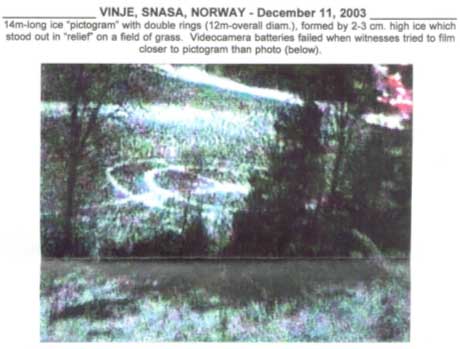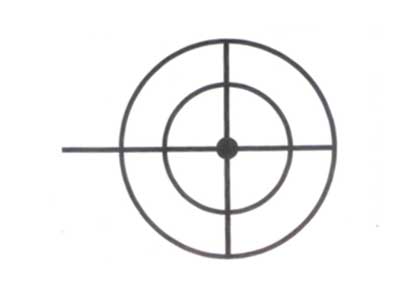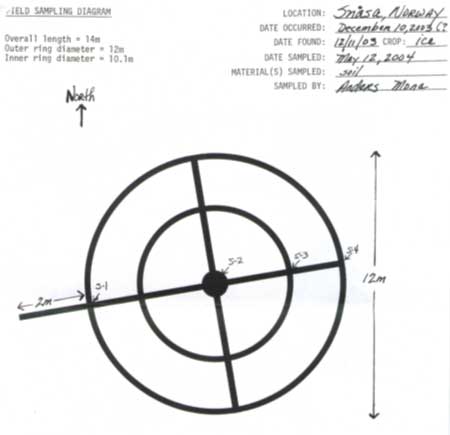17. MAI 2004:
Jordprøver sendt til USA
PRØVETAKING
Etter at snøen hadde smeltet og tela gått i midten av mai, ble det tatt jordprøver der sirkelen hadde ligget. Det var Norsk Kornsirkelgruppes kontaktperson Anders Mona, i samarbeid med grunneier Leif Aune på Snåsa som utførte jobben. Prøvene ble tatt den 12. mai, og ble deretter sendt til BLT Research Team Inc. i USA for laboratorieundersøkelse. Nå venter både Norsk Kornsirkelgruppe og folk på Snåsa spent på eventuelle resultater.
RESULTATER
Kjemisk analyse av jordprøvene viste IKKE noe unormalt
Jordprøvene som ble tatt fra stedet der den 15 m lange isformasjonen lå vinteren 2003/2004, har nå blitt analysert av BLT Research Team, USA:
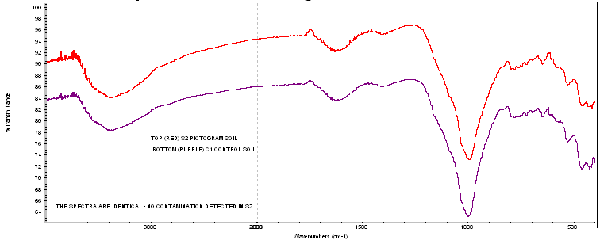
Frontier Analysis Ltd
■ Ingen uvanlige kjemiske forurensninger ble funnet i jordprøvene
som ble tatt inne i isformasjonen, sammenlignet med
kontrollprøvene tatt utenfor (se grafen over).
■ Ammonium nitrat (en vanlig form for kunstgjødsel) ble funnet i like
mengder både i piktogramprøvene og kontrollprøvene, i tillegg til
annet naturlig organisk materiale som finnes i jord, bl.a. en liten
mengde naturlig ester og spor etter voksaktig, langkjedet hydrokarbon.
Jordprøver
Etter anvisning fra BLT Research, ble det ble tatt totalt 8 prøver av jorden fra området der is-mønsteret hadde ligget. Fire ble tatt "innvendig" i sirkelen, (fra indre og ytre ring, forbindelseslinjene og fra sentrum). Fire kontrollprøver ble tatt henholdsvis 20 og 40 meter utenfor formasjonen. Prøvene ble tatt den 12. mai 2004 av Anders Mona og grunneier Leif Aune, og sendt til BLT Research Team Inc., USA, for laboratorie-undersøkelse.
Analyse
Analysen ble utført ved hjelp av infrarød spektroskopi av jordprøver og kontrollprøver "slik de ble mottatt" - samt av 3 forskjellige ekstrakter fra prøvene, frembragt ved tilførsel av henholdsvis Hexane, Acetone:Methanol og vann.
Resultat
Ingen uvanlige kjemiske forurensninger ble funnet i jordprøvene som ble tatt inne i isformasjonen, sammenlignet med kontrollprøvene tatt utenfor (se laboratorie-rapporten fra 17.05.2005 under). Flere stoff ble funnet i både piktogram- og kontrollprøvene. Av disse var ammonium nitrat (en vanlig form for kunsgjødsel) dominerende. Prøvene inneholdt også annet naturlig organisk materiale som forefinnes i jord, bl.a. en liten mengde naturlig ester og spor etter voksaktig, langkjedet hydrokarbon.
Diskusjon
Siden mønsteret i is-formasjonen var dannet av et lag av is som lå oppå bakken, og fordi det ikke er noen kjent struktur under bakken, og heller ikke fins holdepunkter for noen struktur oppå bakken, ble det reist spørsmål om hvorvidt et kjemikalium av noe slag kunne ha vært tilført ovenfra og forårsaket at vann kunne fryse til et slikt mønster av is?
På grunn av at infrarød spektroskopi av både kontroll- og jordprøvene var identiske (og ingen inneholdt fremmede kjemiske urenheter), og fordi kun rester etter ammoniumnitrat (kunstgjødsel) og andre naturlige bestanddeler ble funnet i prøvene, anses hypotesen om et ovenfra tilført kjemikalium som årsaken til dannelsen av mønsteret, for høyst usannsynlig.
Konklusjon
Blt Research Team konkluderer i sin rapport: "Basert på våre nåværende data, kan vi ikke fastslå noen årsak til hvordan mønsteret av is har frosset til".
Les BLTs avsluttende rapport nedenfor!
RAPPORTER
Rapport 6 Mai 2005 Avsluttende rapport fra BLT Research Team Inc, USA - NY!
Resultater fra testene og konklusjon: Ingen unormale funn.
Rapport 5 17.05.05: Rapport fra laboratorie-undersøkelsen - NY!
Analyse v/kjemiker Phyllis A. Budinger, Frontier Research, Ohio, USA
Rapport 4 12.05.04: Jordprøver sendt til USA
Da våren kom, ble det tatt prøver av jorden der sirkelen hadde ligget.
Rapport 3 21.02.04: Gjensyn med IS-sirkelen på Snåsa
Sirkelen uventet tilsyne etter snøsmelting; nye målinger og fotos tatt.
Rapport 2 28.01.04: Kommentarer fra Norsk Kornsirkelgruppe
NKGs første rapport om is-sirkelen og de lokale forhold.
Rapport 1 28.01.04: Observatørenes Beretning
Ungdommenes egen fortelling om funnet 11. des. 2003
TAKK TIL ALLE SOM HAR BIDRATT I UNDERSØKELSEN
Siden is-sirkelen ble funnet i Nord-Trøndelag, ble de lange avstandene mellom Snåsa og Oslo en liten utfordring for Norsk Kornsirkelgruppe. Stor takk til alle på Snåsa (grunneier, observatører, journalister, feltforskere og andre interesserte) for all hjelpsomhet og innsats i forbindelse med undersøkelsen! Takk også til BLT Resarch Team, som utførte laboratorieundersøkelsen av denne meget uvanlige is-formasjonen.
Les BLTs rapport i sin helhet:

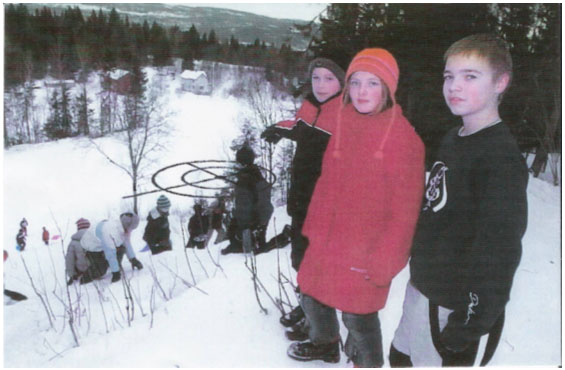
17100 Wood
Acre Trail
Chagrin Falls,
Ohio 44023
Phone/Fax: 440-708-2211
Email:
BudingerPA@MSN.com
TECHNICAL SERVICE RESPONSE NO.:
UT040
Subject:
Analysis of Soils from
an Ice Pictogram Formation which was found in Snasa, Norway (December 2003)
Date:
May 17, 2005
Requested By:
Nancy Talbott
BLT Research
Reported By:
P. A. Budinger
Analytical Scientist
Background/Objective:
The
background as described by Nancy Talbott follows.
“A most unusual
pictogram” was found in Norway in December 2003. It was made up of ice, 2-3 cm
high, formed in rings and pathways. A light snow had fallen on top of the ice
circle making it clearly visible.
The following
spring fieldworkers took 4 soil samples and 4 soil controls in the hopes that
you could look at them for any sign of a contaminant in the soils that might
account for the ground/snow melting and then re-freezing.
Interviews with
locals provided no ready explanation for the marking. The field was simply a
grass field/meadow.
That spring of
2004 showed some of the marking in the growing grass where, apparently, the
grass was not growing normally. From the photo it looks as if the ring areas
may have been mostly dirt in 2004, when sampled. Perhaps some substance has
impeded the growth of the grasses?
The field team
says that lime and fertilizer had been spread on this field by the farmer one
week or so before the soil samples were taken.”
Conclusions:
· No
unusual contamination was detected in the pictogram soil. Either no chemical
was used to produce the pictogram, or it was depleted and dispersed into the
soil long before sampling.
· There
are materials detected in both pictogram and control soils. Ammonium
nitrate predominates. This is from fertilizer. There are also other
natural soil
T. S. R. No.: UT040
Frontier Analysis, Ltd
Page 3
organics,
which include a small amount of natural ester and a very trace level of a waxy
long chain hydrocarbon.
Procedure:
The samples
consist of four soils from the pictogram and four control samples. The
Pictogram was noted In December 2003. The soils were sampled four months later
on12 May 2004.
T. S. R. No.: UT040
Frontier Analysis, Ltd
Page 4
Results:
Analysis of the “As Received “ Soil
Infrared
spectra of the control soil and pictogram soil are identical. That is, the
pictogram soil shows no extraneous contaminant absorption compared to the
control soil. Following are selected spectra of a pictogram soil (S2) and a
control soil (C1) for comparison.
Infrared Spectra of the S2 Pictogram Soil and C1 Control
Soil
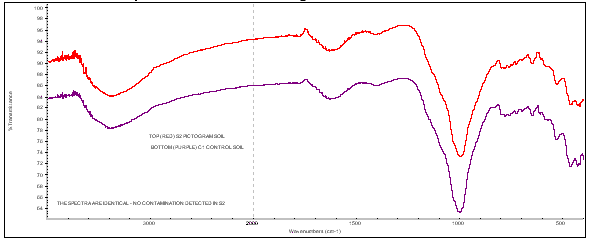
Analysis of the Solvent Extracts from the Soil
The amounts
of extracted material are very low. They are about the same for the pictogram
soils and control soils, i.e. within experimental error. This indicates there is
no contamination present. The amounts for each extract (hexane, 1:1
acetone:methanol, and water) follow.
Amounts of Extracts from the Pictogram Soils and Control
Soils
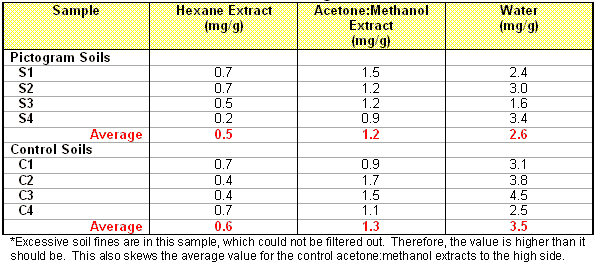
T. S. R. No.: UT040
Frontier Analysis, Ltd
Page 5
Infrared
analysis of the extracts from selected soils from the pictogram and controls
display similar spectra. The spectra show no additional absorption from
contamination in the ring soils when compared those from the controls. The
following components were found in the in the extracts.

Representative spectra from a pictogram soil and control soil from each extract
follow. Pertinent absorption peaks are labeled.
Infrared spectra of Hexane Extracts from a Pictogram Soil
(S2) and a Control Soil (C3)
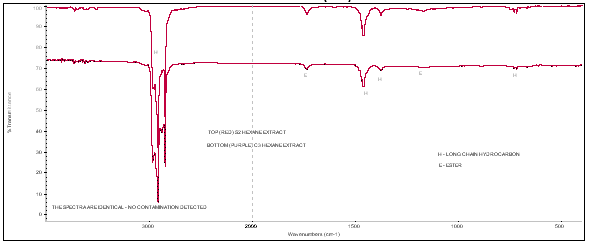
Infrared
spectra of Acetone:Methanol Extracts from a Pictogram Soil (S2) and a Control
Soil (C4)
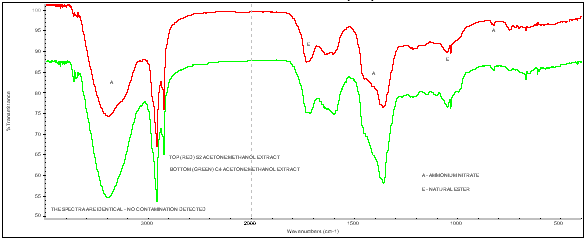
T. S. R. No.: UT040
Frontier Analysis, Ltd
Page 6
Infrared spectra of Water Extracts from a Pictogram Soil
(S2) and a Control Soil (C3)
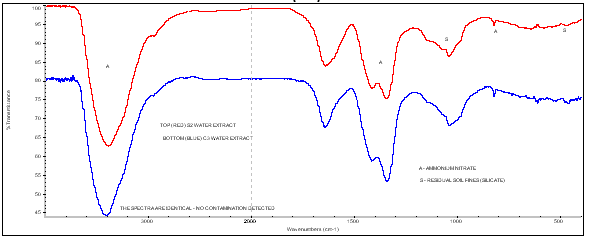
FILE: UT040
_______________



